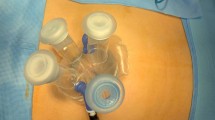Abstract
Traditionally, inguinal hernias have been treated with open Lichtenstein hernioplasty. But in the last 2 decades, the trends have changed with the introduction of laparoscopic inguinal hernia repair techniques mainly by totally extraperitoneal herniorrhaphy. This was a case series analysis of 160 consecutive patients who underwent totally extraperitoneal repair and were included accrual between January 2015 and August 2018 in our single tertiary center. Patient demographics, details of the surgery, postoperative Visual Analogue Scale, return time to work, early and late postoperative complications, recurrence, and chronic pain were evaluated. A hundred seventy-eight repairs were performed in the study cohort (median age, 46.3 years; range, 22–84 years; men, 93%). The mean follow-up was 15 months (range = 12–30). Mean hospital stay time was 22.6 h (range 15–27). The mean surgery time was 55 min (range 35–110). Second day postoperative mean Visual Analogue Scale was 2.3 (range 1–5). The mean return time to their routine work was 8.3 days (range 5–17). Seroma (10%), scrotal pain (9%), scrotal paresthesia (6%), and hydrocele (6%) were the most commonly noted complications. Recurrence was detected in 4 (2.5%) patients. Recurrences were noted at 1st week and 6th month following surgery. Chronic groin pain was reported by 4 (2.5%) patients. Totally extraperitoneal hernia repair has become increasingly applicable among surgeons due to less postoperative pain, short return time to routine work, acceptably few complications, and recurrence rates compared with the other inguinal herniorrhaphy techniques.
Similar content being viewed by others
References
Patchayappan M, Narayanan SN, Duraisamy N (2015) Three stitch hernioplasty: a novel technique for beginners. Avicenna J Med 5(4):106–109
Scheuermann U, Niebisch S, Lyros O, Jansen-Winkeln B, Gockel I (2017) Transabdominal Preperitoneal (TAPP) versus Lichtenstein operation for primary inguinal hernia repair - a systematic review and meta-analysis of randomized controlled trials. BMC Surg 17(1):55
McKernan JB, Laws HL (1993) Laparoscopic repair of inguinal hernias using a totally extraperitoneal prosthetic approach. Surg Endosc 7(1):26–28
Bansal VK, Misra MC, Babu D, Victor J, Kumar S, Sagar R, Rajeshwari S, Krishna A, Rewari V (2013) A prospective, randomized comparison of long-term outcomes: chronic groin pain and quality of life following totally extraperitoneal (TEP) and transabdominal preperitoneal (TAPP) laparoscopic inguinal hernia repair. Surg Endosc 27(7):2373–2382
Evans MD, Williams GL, Stephanson BM (2009) Low recurrence rate after laparoscopic (TEP) and open (Lichtenstein) inguinal hernia repair: a randomized, multicenter trial with 5-year follow up. Ann Surg 250(2):354–355
Messenger DE, Aroori S, Vipond MN (2010) Five-year prospective follow-up of 430 laparoscopic totally extraperitoneal inguinal hernia repairs in 275 patients. Ann R Coll Surg Engl 92(3):201–205
Mihaleanu F, Chiorescu S, Grad O, Negrea V, Silaghi H, Mıronıuc A (2015) The surgical treatment of inguinal hernia using the laparoscopic totally extra-peritoneal (TEP) technique. Clujul Med 88(1):58–64
Köckerling F, Bittner R, Jacob DA, Seidelmann L, Keller T, Adolf D, Kraft B, Kuthe A (2015) TEP versus TAPP: comparison of the perioperative outcome in 17,587 patients with primary unilateral inguinal hernia. Surg Endosc 29(12):3750–3760
Swadia ND (2011) Laparoscopic totally extra-peritoneal inguinal hernia repair: 9 year’s experience. Hernia. 15(3):273–279
Ferzli GS, Khoury GE (2006) Treating recurrence after a totally extraperitoneal approach. Hernia. 10(4):341–346
Edwards CC 2nd, Bailey RW (2000) Laparoscopic hernia repair: the learning curve. Surg Laparosc Endosc Percutan Tech 10(3):149–153
Bansal VK, Krishna A, Misra MC, Kumar S (2016) Learning curve in laparoscopic inguinal hernia repair: experience at a tertiary care centre. Indian J Surg 78(3):197–202
Lim JW, Lee JY, Lee SE, Moon JI, Ra YM, Choi IS, Choi WJ, Yoon DS, Min HS (2012) The learning curve for laparoscopic totally extraperitoneal herniorrhaphy by moving average. J Korean Surg Soc 83(2):92–96
Schouten N, Elshof JW, Simmermacher RK, Van Dalen T, De Meer SG, Clevers GJ, Davids PH, Verleisdonk EJ, Westers P, Burgmans JP (2013) Selecting patients during the “learning curve” of endoscopic totally extraperitoneal (TEP) hernia repair. Hernia 17(6):737–743
Krishna A, Bansal VK, Misra MC, Prajapati O, Kumar S (2019) Totally extraperitoneal repair in inguinal hernia: more than a decade’s experience at a tertiary care hospital. Surg Laparosc Endosc Percutan Tech 29(4):247–251
Prakash P, Bansal VK, Misra MC, Babu D, Sagar R, Krishna A, Kumar S, Rewari V, Subramaniam R (2016) A prospective randomised controlled trial comparing chronic groin pain and quality of life in lightweight versus heavyweight polypropylene mesh in laparoscopic inguinal hernia repair. J Minim Access Surg 12(2):154–161
Reiner MA, Bresnahan ER (2016) Laparoscopic total extra-peritoneal hernia repair outcomes. JSLS. 20(3):e2016.00043
Sevinç B, Damburacı N, Güner M, Karahan Ö (2019) Comparison of early and long term outcomes of open Lichtenstein repair and totally extra-peritoneal herniorrhaphy for primary inguinal hernias. Turk J Med Sci 49(1):38–41
Memon MA, Cooper NJ, Memon B, Memon MI, Abrams KR (2003) Meta-analysis of randomized clinical trials comparing open and laparoscopic inguinal hernia repair. Br J Surg 90(12):1479–1492
Köckerling F, Simons MP (2018) Current concepts of inguinal hernia repair. Visc Med 34(2):145–150
Acknowledgments
We thank Dr. Mustafa Uygar Kalaycı for encouraging us to perform laparoscopic repairs.
Author information
Authors and Affiliations
Contributions
Study conception and design: Yasin Kara and Hakan Bölükbasi
Acquisition of data: Yasin Kara
Analysis and interpretation of data: Yasin Kara
Drafting of manuscript: Yasin Kara and Hakan Bölükbasi
Critical revision: Yasin Kara and Hakan Bölükbasi.
Corresponding author
Ethics declarations
Approval was given by the ethical committee of Ministry of Health, University of Health Science, Kanuni Sultan Süleyman Training and Research Hospital—no.: KAEK/2019.04.96. This study was carried out according to the principles of the Helsinki Declaration. All the patients were routinely informed and provided their written consent.
Conflict of Interest
The authors declare that they have no conflict of interest.
Additional information
Publisher’s Note
Springer Nature remains neutral with regard to jurisdictional claims in published maps and institutional affiliations.
Rights and permissions
About this article
Cite this article
Kara, Y., Bolukbasi, H. Laparoscopic Totally Extraperitoneal Hernia Repairs: a Case Series Analysis. Indian J Surg 83, 255–260 (2021). https://doi.org/10.1007/s12262-020-02416-3
Received:
Accepted:
Published:
Issue Date:
DOI: https://doi.org/10.1007/s12262-020-02416-3




